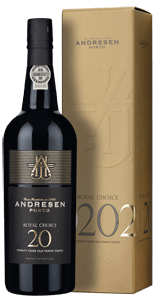Filter by
- Ready to sip and savour ruby port from one of the last truly family owned shippers£14.99 per bottleSAVE £4.00
- Indulge yourself with this wonderfully mellow tawny port from the Andresen family lodge£29.99 per bottleSAVE £3.01
- Showing (1 to 2 of 2)
1
Page 1 of 1
Wine FAQs
How is a fortified wine made?
Fortified wines are still wines that have had additional alcohol added to them.
During fermentation, a distilled grape spirit, such as brandy, is added to wine. This stops fermentation by killing the yeast and boosts the wine’s alcohol content to between 18-20% ABV.
The timing of this extra alcohol addition impacts a wine’s final taste and body. If introduced while the wine has a decent amount of grape sugar, the outcome is a sweeter fortified wine. If added after the yeast has converted most of the natural sugars into alcohol, the end wine tends to be drier.
Ageing is another crucial step in making fortified wine. Fortified wines are aged in either bottles or barrels, spanning from a few years to several decades. This ageing process adds layers of complexity and influences the wine’s final flavour.
Port and Sherry are the best-known types of fortified wine, typically enjoyed in small glasses to enhance their rich fruit flavours. Other wines such as Madeira, Vermouth and Marsala are fortified wines often used in cooking to add flavour to a wide range of sweet and savoury dishes.
What are the different types and styles of fortified wine?
Fortified wines range in style, from dry and nutty to rich and sweet. Some of the more well-known fortified wines include:
Red Port: a richly sweet and full-bodied fortified wine from northern Portugal, Port comes in various styles. The most popular are Ruby Port and Tawny Port. Ruby Port is a vibrant crimson-coloured wine with deep, sweet fruit flavours and a chocolatey aroma. Aged for longer than Ruby Port, Tawny Port has a lighter brown colour and delivers hints of nuts, dried fruit and toffee.
White Port: is made from white grapes and aged in oak barrels. As it matures, it adds deeper, nutty undertones to its floral and citrus notes. This versatile fortified wine is perfect for sipping as an aperitif, mixing in cocktails or pairing with seafood dishes.
Madeira: made on the Portuguese island of the same name, this wine is famous for its ageing potential. Its flavours are a rich mix of caramel, nuts and dried fruit, with warming hints of cinnamon and nutmeg.
Marsala: an Italian classic, Marsala is a favourite thanks to its sweet, nutty flavour. Besides being a delicious, slow-sipping drink, it’s a staple in many kitchens, adding flavour to savoury sauces and desserts.
Sherry: is a gem from the wine-growing region of Jerez in Southwestern Spain. Fino is the most popular style, standing out because of its dry style and almond-sea salt flavours. Manzanilla, a coastal version of Fino, is similar but with an extra hint of salinity.
Vermouth: A speciality from parts of Italy and France, Vermouth is instantly recognisable by its herbal and spicy flavours and characteristic hints of bitterness. It’s the secret behind iconic cocktails such as the Martini and Negroni Sbagliato.
How do I serve fortified wine?
Fortified wines like cooler serving temperatures. So, to get the best from your bottle, serve your fortified wine slightly chilled, but not cold. Here’s a quick guide to get it just right:
- Ruby and Tawny Port: aim for 12-16°C.
- White Port: best between 10-12°C.
- Madeira: a cosy 12-13°C does the trick.
- Marsala: ideal at 12-15°C.
- Fino and Manzanilla Sherries: they’re happiest at 7-13°C.
- Vermouth: keep it between 7-12°C.
When it’s time to pour, reach for a traditional Port glass or a small tulip-shaped one. These glasses aren’t just for show – they’re designed to bring out the best in fortified wines, emphasising their rich aromas. Remember, with fortified wines, it’s all about savouring each sip.
Thinking of the perfect end to your meal? Fortified wines have got you covered. Pair them with dessert, or let them be the dessert. For the sweeter wines such as Ruby Port, think chocolates and cheeses. A drier Tawny Port is great with savoury treats such as salted nuts and charcuterie boards.
How long does fortified wine last after opening?
Thanks to their generous alcohol and sugar content, fortified wines have more staying power once opened. But not as long as you might think … they’re still wines after all.
A good rule is to reseal the bottle tightly and stick them in a cool, dry spot away from direct light – they will last a couple of weeks.
Some fortified wines, like Sherry and Port, have a longer lifespan because they contain brandy, while others, such as Marsala and Madeira, can last for several years once opened as they are already oxidised.






